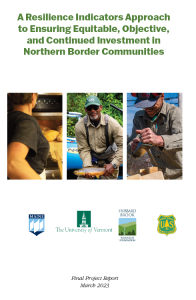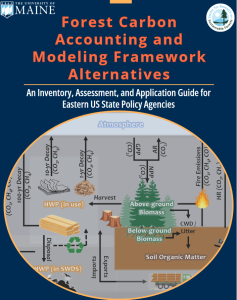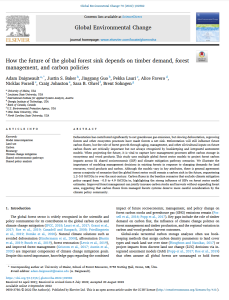Publications
Please see Dr. Daigneault’s Google Scholar page for a full list of publications.
Select Lab Publications
Abstract: Deforestation has contributed significantly to net greenhouse gas emissions, but slowing deforestation, regrowing forests and other ecosystem processes have made forests a net sink. Deforestation will still influence future carbon fluxes, but the role of forest growth through aging, management, and other silvicultural inputs on future carbon fluxes are critically important but not always recognized by bookkeeping and integrated assessment models. When projecting the future, it is vital to capture how management processes affect carbon storage in ecosystems and wood products. This study uses multiple global forest sector models to project forest carbon impacts across 81 shared socioeconomic (SSP) and climate mitigation pathway scenarios. We illustrate the importance of modeling management decisions in existing forests in response to changing demands for land resources, wood products and carbon. Although the models vary in key attributes, there is general agreement across a majority of scenarios that the global forest sector could remain a carbon sink in the future, sequestering 1.2–5.8 GtCO2e/yr over the next century. Carbon fluxes in the baseline scenarios that exclude climate mitigation policy ranged from −0.8 to 4.9 GtCO2e/yr, highlighting the strong influence of SSPs on forest sector model estimates. Improved forest management can jointly increase carbon stocks and harvests without expanding forest area, suggesting that carbon fluxes from managed forests systems deserve more careful consideration by the climate policy community.
Climate change in the context of whole-farming systems: opportunities for improved research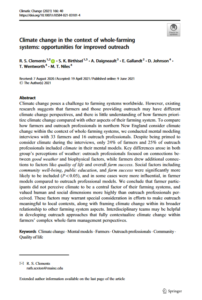
Ruthie S. Clements, Sonja K. Birthisel, Adam Daigneault, Eric Gallandt, Devon Johnson, Thomas Wentworth, Meredith T. Niles
Published in Climatic Change, June 2021
Abstract: Climate change poses a challenge to farming systems worldwide. However, existing research suggests that farmers and those providing outreach may have different climate change perspectives, and there is little understanding of how farmers prioritize climate change compared with other aspects of their farming system. To compare how farmers and outreach professionals in northern New England consider climate change within the context of whole-farming systems, we conducted mental modeling interviews with 33 farmers and 16 outreach professionals. Despite being primed to consider climate during the interviews, only 24% of farmers and 25% of outreach professionals included climate in their mental models. Key differences arose in both group’s perceptions of weather: outreach professionals focused on connections between good weather and biophysical factors, while farmers drew additional connections to factors like quality of life and overall farm success. Social factors including community well-being, public education, and farm success were significantly more likely to be included (P < 0.05), and in some cases were more influential, in farmer models compared to outreach professional models. We conclude that farmer participants did not perceive climate to be a central factor of their farming systems, and valued human and social dimensions more highly than outreach professionals perceived. These factors may warrant special consideration in efforts to make outreach meaningful to local contexts, along with framing climate change within its broader relationship to other farming system aspects. Interdisciplinary teams may be helpful in developing outreach approaches that fully contextualize climate change within farmers’ complex whole-farm management perspectives.
Forests: Carbon sequestration, biomass energy, or both?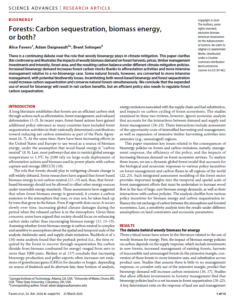
Alice Favero, Adam Daigneault, Brent Sohngen
Published in Science Advances, March 2020
Abstract: There is a continuing debate over the role that woody bioenergy plays in climate mitigation. This paper clarifies this controversy and illustrates the impacts of woody biomass demand on forest harvests, prices, timber management investments and intensity, forest area, and the resulting carbon balance under different climate mitigation policies. Increased bioenergy demand increases forest carbon stocks thanks to afforestation activities and more intensive management relative to a no-bioenergy case. Some natural forests, however, are converted to more intensive management, with potential biodiversity losses. Incentivizing both wood-based bioenergy and forest sequestration could increase carbon sequestration and conserve natural forests simultaneously. We conclude that the expanded use of wood for bioenergy will result in net carbon benefits, but an efficient policy also needs to regulate forest carbon sequestration.
.
Developing Detailed Shared Socioeconomic Pathway (SSP) Narratives for the Global Forest Sector 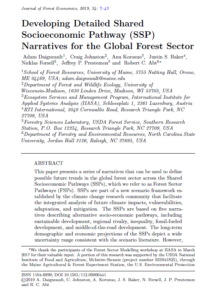
Adam Daigneault, Craig Johnston, Ana Korosuo, Justin Baker, Nicklas Forsell, Jeffrey Prestemon and Robert Abt
Published in Journal of Forest Economics, July 2019
Abstract: This paper presents a series of narratives that can be used to define possible future trends in the global forest sector across the Shared Socioeconomic Pathways (SSPs), which we refer to as Forest Sector Pathways (FSPs). SSPs are part of a new scenario framework established by the climate change research community that facilitate the integrated analysis of future climate impacts, vulnerabilities, adaptation, and mitigation. The SSPs are based on five narratives describing alternative socio-economic pathways, including sustainable development, regional rivalry, inequality, fossil-fueled development, and middle-of-the-road development. The long-term demographic and economic projections of the SSPs depict a wide uncertainty range consistent with the scenario literature. However, the literature on sector-specific narratives outside of the energy and industrial sectors is currently limited, and this paper seeks to build upon existing SSP storylines by elaborating on the potential implications of SSP-related variables on forest resource management, forest product markets, wood-based bioenergy expansion, and other relevant trends in global forestry. The global forestry pathway narratives presented in this paper build on alternative futures research and multi-model inter-comparisons by further developing recent narratives with additional detail on specific issues related to the development and use of our world’s forests.

